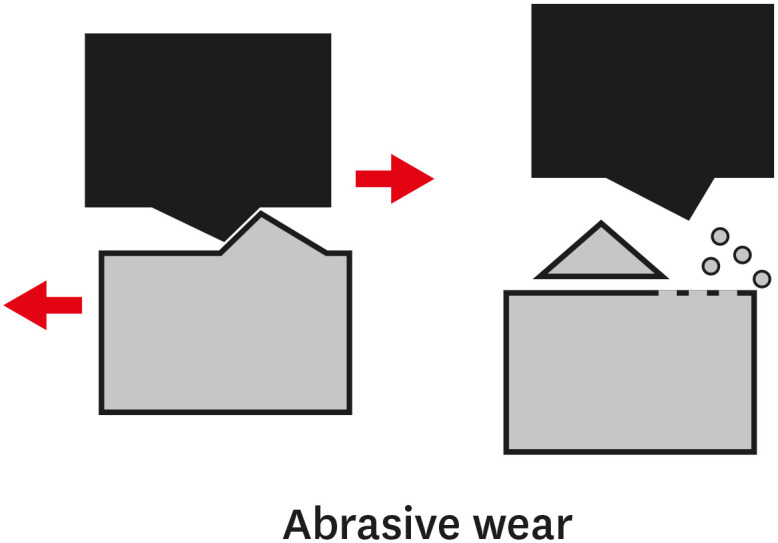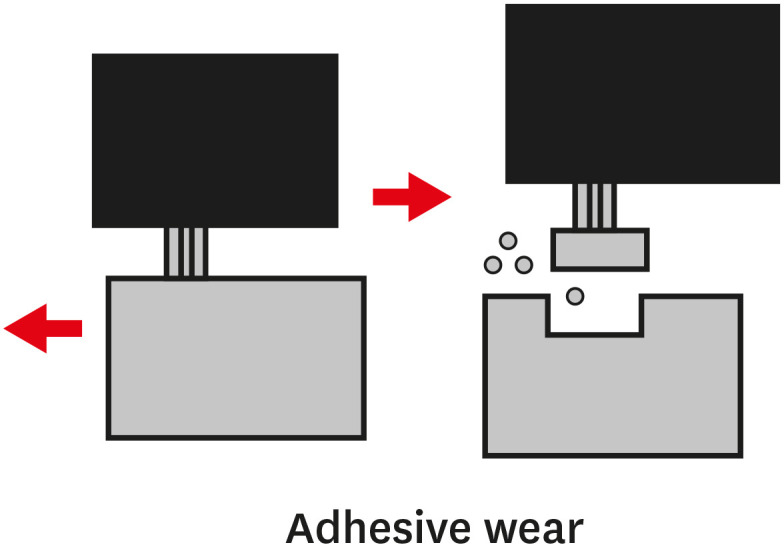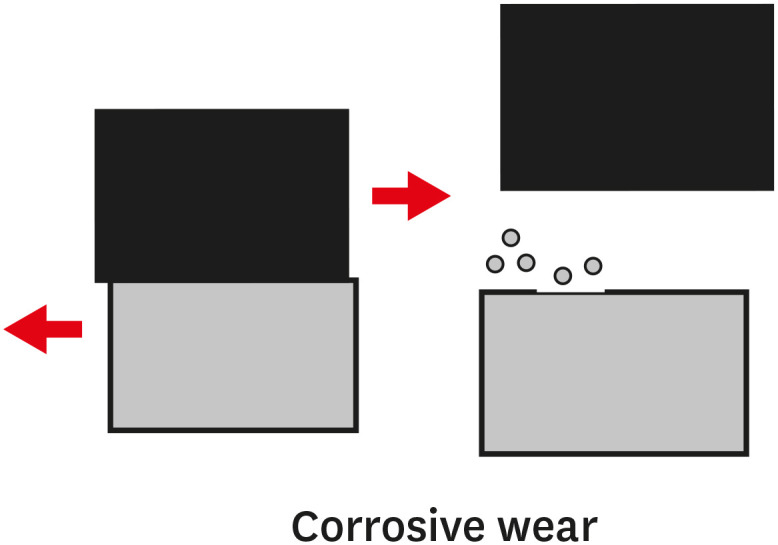Restor Dent Endod.
2021 May;46(2):e18. 10.5395/rde.2021.46.e18.
Wear of contemporary dental composite resin restorations: a literature review
- Affiliations
-
- 1Department of Operative Dentistry, Faculty of Dentistry, School of Health Sciences, Aristotle University of Thessaloniki, Thessaloniki, Greece
- KMID: 2548062
- DOI: http://doi.org/10.5395/rde.2021.46.e18
Abstract
- Composite resins are the most commonly used dental restorative materials after minimally invasive dental procedures, and they offer an aesthetically pleasing appearance. An ideal composite restorative material should have wear properties similar to those of tooth tissues. Wear refers to the damaging, gradual loss or deformation of a material at solid surfaces. Depending on the mechanism of action, wear can be categorized as abrasive, adhesive, fatigue, or corrosive. Currently used composite resins cover a wide range of materials with diverse properties, offering dental clinicians multiple choices for anterior and posterior teeth. In order to improve the mechanical properties and the resistance to wear of composite materials, many types of monomers, silane coupling agents, and reinforcing fillers have been developed. Since resistance to wear is an important factor in determining the clinical success of composite resins, the purpose of this literature review was to define what constitutes wear. The discussion focuses on factors that contribute to the extent of wear as well as to the prevention of wear. Finally, the behavior of various types of existing composite materials such as nanohybrid, flowable, and computer-assisted design/computer-assisted manufacturing materials, was investigated, along with the factors that may cause or contribute to their wear.
Figure
Reference
-
1. Gwon B, Bae EB, Lee JJ, Cho WT, Bae HY, Choi JW, Huh JB. Wear characteristics of dental ceramic CAD/CAM materials opposing various dental composite resins. Materials (Basel). 2019; 12:1839.
Article2. Lambrechts P, Braem M, Vuylsteke-Wauters M, Vanherle G. Quantitative in vivo wear of human enamel. J Dent Res. 1989; 68:1752–1754. PMID: 2600255.3. Ferracane JL. Resin composite--State of the art. Dent Mater. 2011; 27:29–38. PMID: 21093034.
Article4. Burke FJ. Amalgam to tooth-coloured materials--implications for clinical practice and dental education: governmental restrictions and amalgam-usage survey results. J Dent. 2004; 32:343–350. PMID: 15193781.
Article5. Kakaboura A, Vougiouklakis G. Basic principles of operative dentistry. Athens: Paschalidis;2012.6. de Gee AJ, Wendt SL, Werner A, Davidson CL. Influence of enzymes and plaque acids on in vitro wear of dental composites. Biomaterials. 1996; 17:1327–1332. PMID: 8805981.
Article7. Turssi CP, De Moraes Purquerio B, Serra MC. Wear of dental resin composites: insights into underlying processes and assessment methods--a review. J Biomed Mater Res B Appl Biomater. 2003; 65:280–285. PMID: 12687721.
Article8. Tsujimoto A, Barkmeier WW, Fischer NG, Nojiri K, Nagura Y, Takamizawa T, Latta MA, Miazaki M. Wear of resin composites: current insights into underlying mechanisms, evaluation methods and influential factors. Jpn Dent Sci Rev. 2018; 54:76–87. PMID: 29755618.
Article9. Ferracane JL. Is the wear of dental composites still a clinical concern? Is there still a need for in vitro wear simulating devices? Dent Mater. 2006; 22:689–692. PMID: 16563492.
Article10. Heintze SD, Ilie N, Hickel R, Reis A, Loguercio A, Rousson V. Laboratory mechanical parameters of composite resins and their relation to fractures and wear in clinical trials-A systematic review. Dent Mater. 2017; 33:e101–e114. PMID: 27993372.
Article11. Heintze SD, Rousson V. Clinical effectiveness of direct class II restorations - a meta-analysis. J Adhes Dent. 2012; 14:407–431. PMID: 23082310.12. McCabe JF, Molyvda S, Rolland SL, Rusby S, Carrick TE. Two-and three-body wear of dental restorative materials. Int Dent J. 2002; 52:406–416.
Article13. Popov VL. Is tribology approaching its golden age? Grand challenges in engineering education and tribological research. Front Mech Eng. 2018; 4:16.
Article14. Blau PJ, Bayer RG. Wear of materials. Amsterdam: Elsevier;2003.15. Yang LJ. Wear coefficient equation for aluminium-based matrix composites against steel disc. Wear. 2003; 255:579–592.
Article16. Nihei T, Dabanoglu A, Teranaka T, Kurata S, Ohashi K, Kondo Y, Yoshino N, Hickel R, Kunzelmann KH. Three-body-wear resistance of the experimental composites containing filler treated with hydrophobic silane coupling agents. Dent Mater. 2008; 24:760–764. PMID: 17964643.
Article17. Ghazal M, Kern M. Wear of human enamel and nano-filled composite resin denture teeth under different loading forces. J Oral Rehabil. 2009; 36:58–64. PMID: 18976262.
Article18. Turssi CP, Ferracane JL, Serra MC. Abrasive wear of resin composites as related to finishing and polishing procedures. Dent Mater. 2005; 21:641–648. PMID: 15978273.
Article19. de Paula AB, Fucio SB, Ambrosano GM, Alonso RC, Sardi JC, Puppin-Rontani RM. Biodegradation and abrasive wear of nano restorative materials. Oper Dent. 2011; 36:670–677. PMID: 21913859.
Article20. Mair LH, Stolarski TA, Vowles RW, Lloyd CH. Wear: mechanisms, manifestations and measurement. Report of a workshop. J Dent. 1996; 24:141–148. PMID: 8636486.
Article21. American Society for Testing and Materials. Standard terminology relating to wear and erosion. Annual book of ASTM standards. Vol 03.02. West Conshohocken, PA: American Society for Testing and Materials;1987. p. 243–250.22. Ferracane JL. Materials in dentistry: principle and application. Philadelphia, PA: Lippincott Williams & Wilkins;2001.23. ASM Handbook Committee. ASM handbook. Volume 18: Friction, lubrication and wear technology. Almere: ASM International;2002.24. ISO 9352: Plastics—Determination of resistance to wear by abrasive wheels. Geneve: International Organization for Standardization;2012.25. ASTM D4060: Standard test method for abrasion resistance of organic coatings by the taber abraser. West Conshohocken, PA: American Society for Testing and Materials;2019.26. Cavalcante LM, Masouras K, Watts DC, Pimenta LA, Silikas N. Effect of nanofillers' size on surface properties after toothbrush abrasion. Am J Dent. 2009; 22:60–64. PMID: 19281115.27. Han JM, Zhang H, Choe HS, Lin H, Zheng G, Hong G. Abrasive wear and surface roughness of contemporary dental composite resin. Dent Mater J. 2014; 33:725–732. PMID: 25007731.
Article28. Turssi CP, Ferracane JL, Vogel K. Filler features and their effects on wear and degree of conversion of particulate dental resin composites. Biomaterials. 2005; 26:4932–4937. PMID: 15769527.
Article29. Manhart J, Kunzelmann KH, Chen HY, Hickel R. Mechanical properties and wear behavior of light-cured packable composite resins. Dent Mater. 2000; 16:33–40. PMID: 11203521.
Article30. Krejci I, Albert P, Lutz F. The influence of antagonist standardization on wear. J Dent Res. 1999; 78:713–719. PMID: 10029471.
Article31. Stachowiak GW, Batchelor AW. Engineering tribology. Burlington: Elsevier Butterworth-Heinemann;2005.32. Yap AU, Teoh SH, Hastings GW, Lu CS. Comparative wear ranking of dental restorative materials utilizing different wear simulation modes. J Oral Rehabil. 1997; 24:574–580. PMID: 9291250.
Article33. Mandel ID. The functions of saliva. J Dent Res. 1987; 66(Spec No):623–627. PMID: 3497964.
Article34. Mair LH. Subsurface compression fatigue in seven dental composites. Dent Mater. 1994; 10:111–115. PMID: 7758846.
Article35. McCabe JF, Wang Y, Braem M. Surface contact fatigue and flexural fatigue of dental restorative materials. J Biomed Mater Res. 2000; 50:375–380. PMID: 10737879.
Article36. Söderholm KJ, Richards ND. Wear resistance of composites: a solved problem? Gen Dent. 1998; 46:256–263. PMID: 9693539.37. Ilie N, Hickel R. Resin composite restorative materials. Aust Dent J. 2011; 56(Supplement 1):59–66. PMID: 21564116.
Article38. Finlay N, Hahnel S, Dowling AH, Fleming GJ. The in vitro wear behavior of experimental resin-based composites derived from a commercial formulation. Dent Mater. 2013; 29:365–374. PMID: 23333236.
Article39. Barkmeier WW, Erickson RI, Latta MA, Wilwerding TM. Wear rates of resin composites. Oper Dent. 2013; 38:226–233. PMID: 22856679.
Article40. Barkmeier WW, Takamizawa T, Erickson RL, Tsujimoto A, Latta M, Miyazaki M. Localized and generalized simulated wear of resin composites. Oper Dent. 2015; 40:322–335. PMID: 25706614.
Article41. Mitra SB, Wu D, Holmes BN. An application of nanotechnology in advanced dental materials. J Am Dent Assoc. 2003; 134:1382–1390. PMID: 14620019.
Article42. Egilmez F, Ergun G, Cekic-Nagas I, Vallittu PK, Lassila LV. Estimation of the surface gloss of dental nano composites as a function of color measuring geometry. Am J Dent. 2012; 25:220–226. PMID: 23082386.43. Sideridou ID, Karabela MM, Vouvoudi EC. Physical properties of current dental nanohybrid and nanofill light-cured resin composites. Dent Mater. 2011; 27:598–607. PMID: 21477852.
Article44. Ilie N, Rencz A, Hickel R. Investigations towards nano-hybrid resin-based composites. Clin Oral Investig. 2013; 17:185–193.
Article45. Hahnel S, Schultz S, Trempler C, Ach B, Handel G, Rosentritt M. Two-body wear of dental restorative materials. J Mech Behav Biomed Mater. 2011; 4:237–244. PMID: 21316610.
Article46. Oliveira GU, Mondelli RF, Charantola Rodrigues M, Franco EB, Ishikiriama SK, Wang L. Impact of filler size and distribution on roughness and wear of composite resin after simulated toothbrushing. J Appl Oral Sci. 2012; 20:510–516. PMID: 23138735.
Article47. Takahashi H, Finger WJ, Endo T, Kanehira M, Koottathape N, Komatsu M, Balkenhol M. Comparative evaluation of mechanical characteristics of nanofiller containing resin composites. Am J Dent. 2011; 24:264–270. PMID: 22165452.48. Seemann R, Pfefferkorn F, Hickel R. Behaviour of general dental practitioners in Germany regarding posterior restorations with flowable composites. Int Dent J. 2011; 61:252–256. PMID: 21995372.
Article49. Lawson NC, Radhakrishnan R, Givan DA, Ramp LC, Burgess JO. Two-year randomized, controlled clinical trial of a flowable and conventional composite in class I restorations. Oper Dent. 2015; 40:594–602. PMID: 26237643.
Article50. Sumino N, Tsubota K, Takamizawa T, Shiratsuchi K, Miyazaki M, Latta MA. Comparison of the wear and flexural characteristics of flowable resin composites for posterior lesions. Acta Odontol Scand. 2013; 71:820–827. PMID: 23638859.
Article51. Shinkai K, Taira Y, Suzuki S, Suzuki M. In vitro wear of flowable resin composite for posterior restorations. Dent Mater J. 2016; 35:37–44. PMID: 26843441.
Article52. Tsujimoto A, Barkmeier WW, Takamizawa T, Latta MA, Miyazaki M. Mechanical properties, volumetric shrinkage and depth of cure of short fiber-reinforced resin composite. Dent Mater J. 2016; 35:418–424. PMID: 27251997.
Article53. Dionysopoulos D, Tolidis K, Gerasimou P. Polymerization efficiency of bulk-fill dental resin composites with different curing modes. J Appl Polym Sci. 2016; 133:43392.
Article54. Magno MB, Nascimento GC, Rocha YS, Ribeiro BD, Loretto SC, Maia LC. Silorane-based composite resin restorations are not better than conventional composites – a meta-analysis of clinical studies. J Adhes Dent. 2016; 18:375–386. PMID: 27695714.55. Torres C, Augusto MG, Mathias-Santamaria IF, Di Nicoló R, Borges AB. Pure ormocer vs methacrylate composites on posterior teeth: a double-blinded randomized clinical trial. Oper Dent. 2020; 45:359–367. PMID: 32053457.
Article56. Dejak B, Młotkowski A. A comparison of stresses in molar teeth restored with inlays and direct restorations, including polymerization shrinkage of composite resin and tooth loading during mastication. Dent Mater. 2015; 31:e77–e87. PMID: 25544104.
Article57. Tanoue N, Murakami M, Koizumi H, Atsuta M, Matsumura H. Depth of cure and hardness of an indirect composite polymerized with three laboratory curing units. J Oral Sci. 2007; 49:25–29. PMID: 17429179.
Article58. Yamamoto T, Nakamura Y, Nishide A, Kubota Y, Momoi Y. Contraction stresses in direct and indirect composite restorations compared by crack analysis. J Adhes Dent. 2013; 15:47–54. PMID: 23534000.59. Hirata M, Koizumi H, Tanoue N, Ogino T, Murakami M, Matsumura H. Influence of laboratory light sources on the wear characteristics of indirect composites. Dent Mater J. 2011; 30:127–135. PMID: 21415552.
Article60. Ferracane JL, Condon JR. Post-cure heat treatments for composites: properties and fractography. Dent Mater. 1992; 8:290–295. PMID: 1303369.
Article61. Angeletaki F, Gkogkos A, Papazoglou E, Kloukos D. Direct versus indirect inlay/onlay composite restorations in posterior teeth. A systematic review and meta-analysis. J Dent. 2016; 53:12–21. PMID: 27452342.
Article62. da Veiga AM, Cunha AC, Ferreira DM, da Silva Fidalgo TK, Chianca TK, Reis KR, Maia LC. Longevity of direct and indirect resin composite restorations in permanent posterior teeth: a systematic review and meta-analysis. J Dent. 2016; 54:1–12. PMID: 27523636.
Article63. Mandikos MN, McGivney GP, Davis E, Bush PJ, Carter JM. A comparison of the wear resistance and hardness of indirect composite resins. J Prosthet Dent. 2001; 85:386–395. PMID: 11319537.
Article64. Furuichi T, Takamizawa T, Tsujimoto A, Miyazaki M, Barkmeier WW, Latta MA. Mechanical properties and sliding-impact wear resistance of self-adhesive resin cements. Oper Dent. 2016; 41:E83–E92. PMID: 26918929.
Article65. Tsujimoto A, Barkmeier WW, Takamizawa T, Watanabe H, Johnson WW, Latta MA, Miyazaki M. Simulated localized wear of resin luting cements for universal adhesive systems with different curing mode. J Oral Sci. 2018; 60:29–36. PMID: 29375099.
Article66. Takamizawa T, Barkmeier WW, Latta MA, Berry TP, Tsujimoto A, Miyazaki M. Simulated wear of self-adhesive resin cements. Oper Dent. 2016; 41:327–338. PMID: 26669501.
Article67. Tsujimoto A, Barkmeier WW, Takamizawa T, Latta MA, Miayazaki M. Relationship between simulated gap wear and generalized wear of resin luting cements. Oper Dent. 2017; 42:E148–E158. PMID: 28829931.
Article68. Miyazaki T, Hotta Y. CAD/CAM systems available for the fabrication of crown and bridge restorations. Aust Dent J. 2011; 56(Supplement 1):97–106.
Article69. Yoshida F, Tsujimoto A, Ishii R, Nojiri K, Takamizawa T, Miyazaki M, Latta MA. Influence of surface treatment of contaminated lithium disilicate and leucite glass ceramics on surface free energy and bond strength of universal adhesives. Dent Mater J. 2015; 34:855–862. PMID: 26632235.
Article70. Kömürcüoğlu MB, Sağırkaya E, Tulga A. Influence of different surface treatments on bond strength of novel CAD/CAM restorative materials to resin cement. J Adv Prosthodont. 2017; 9:439–446. PMID: 29279763.
Article71. Alamoush RA, Silikas N, Salim N, Al-Nasrawi S, Satterthwaite JD. Effect of the composition of CAD/CAM composite blocks on mechanical properties. Biomed Res Int. 2018; 2018:4893143. PMID: 30426009.
Article72. Papadopoulos C, Dionysopoulos D, Tolidis K, Kouros P, Koliniotou-Koumpia E, Tsitrou EA. Structural integrity evaluation of large MOD restorations fabricated with a bulk-fill and a CAD-CAM resin composite material. Oper Dent. 2019; 44:312–321. PMID: 30444690.
Article73. Magne P, Dietschi D, Holz J. Esthetic restorations for posterior teeth: practical and clinical considerations. Int J Periodontics Restorative Dent. 1996; 16:104–119. PMID: 9084299.74. Ilie N, Bucuta S, Draenert M. Bulk-fill resin-based composites: an in vitro assessment of their mechanical performance. Oper Dent. 2013; 38:618–625. PMID: 23570302.
Article75. Wassell RW, Walls AW, McCabe JF. Direct composite inlays versus conventional composite restorations: 5-year follow-up. J Dent. 2000; 28:375–382. PMID: 10856800.
Article76. Ruse ND, Sadoun MJ. Resin-composite blocks for dental CAD/CAM applications. J Dent Res. 2014; 93:1232–1234. PMID: 25344335.
Article77. Lawson NC, Bansal R, Burgess JO. Wear, strength, modulus and hardness of CAD/CAM restorative materials. Dent Mater. 2016; 32:e275–e283. PMID: 27639808.
Article78. Lauvahutanon S, Takahashi H, Shiozawa M, Iwasaki N, Asakawa Y, Oki M, Finger WJ, Arksornnukit M. Mechanical properties of composite resin blocks for CAD/CAM. Dent Mater J. 2014; 33:705–710. PMID: 25273052.
Article79. Tsujimoto A, Barkmeier WW, Takamizawa T, Latta MA, Miyazaki M. Influence of thermal cycling on flexural properties and simulated wear of computer-aided design/computer-aided manufacturing resin composites. Oper Dent. 2017; 42:101–110. PMID: 27802120.
Article80. Papadopoulos K, Pahinis K, Saltidou K, Dionysopoulos D, Tsitrou E. Evaluation of the surface characteristics of dental CAD/CAM materials after different surface treatments. Materials (Basel). 2020; 13:981.
Article81. Dionysopoulos D. Smart materials in dentistry. Stoma (Thessaloniki). 2016; 44:83–92.
- Full Text Links
- Actions
-
Cited
- CITED
-
- Close
- Share
- Similar articles
-
- COMPARISON OF WEAR RESISTANCE AMONG RESIN DENTURE TEETH OPPOSING VARIOUS RESTORATIVE MATERIALS
- The shear bond strength of two adhesives bonded to composite resin and glass ionomer cement restorations
- A 3-year retrospective study of clinical durability of bulk-filled resin composite restorations
- 5 Year Cumulative Survival Rate of Composite Resin Restorations in Permanent First Molars
- Wear resistance of indirect composite resins used for provisional restorations supported by implants





